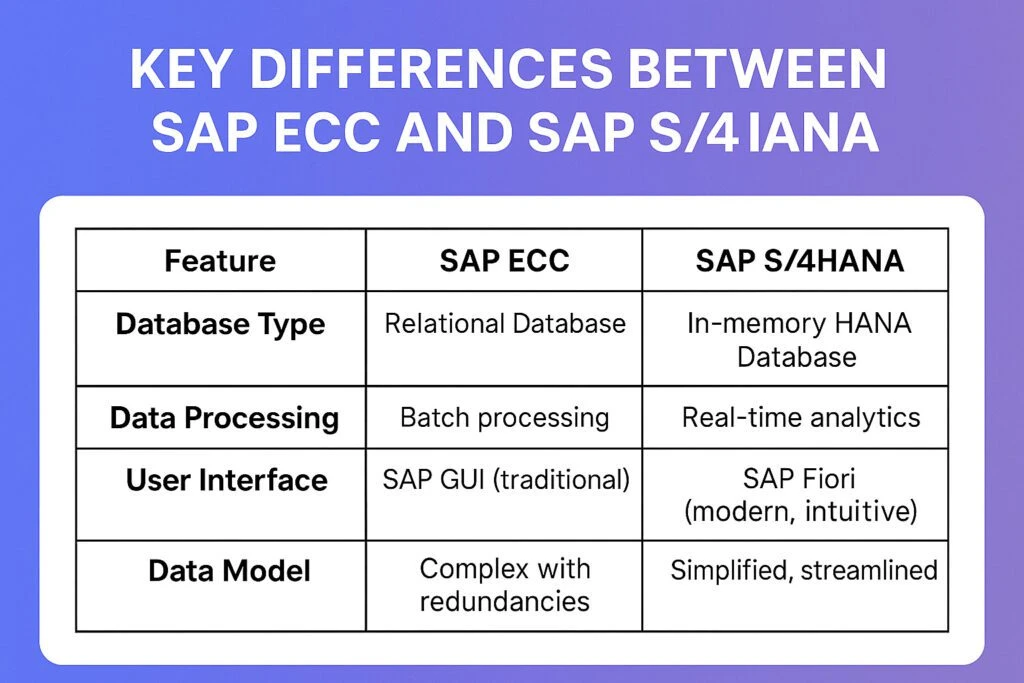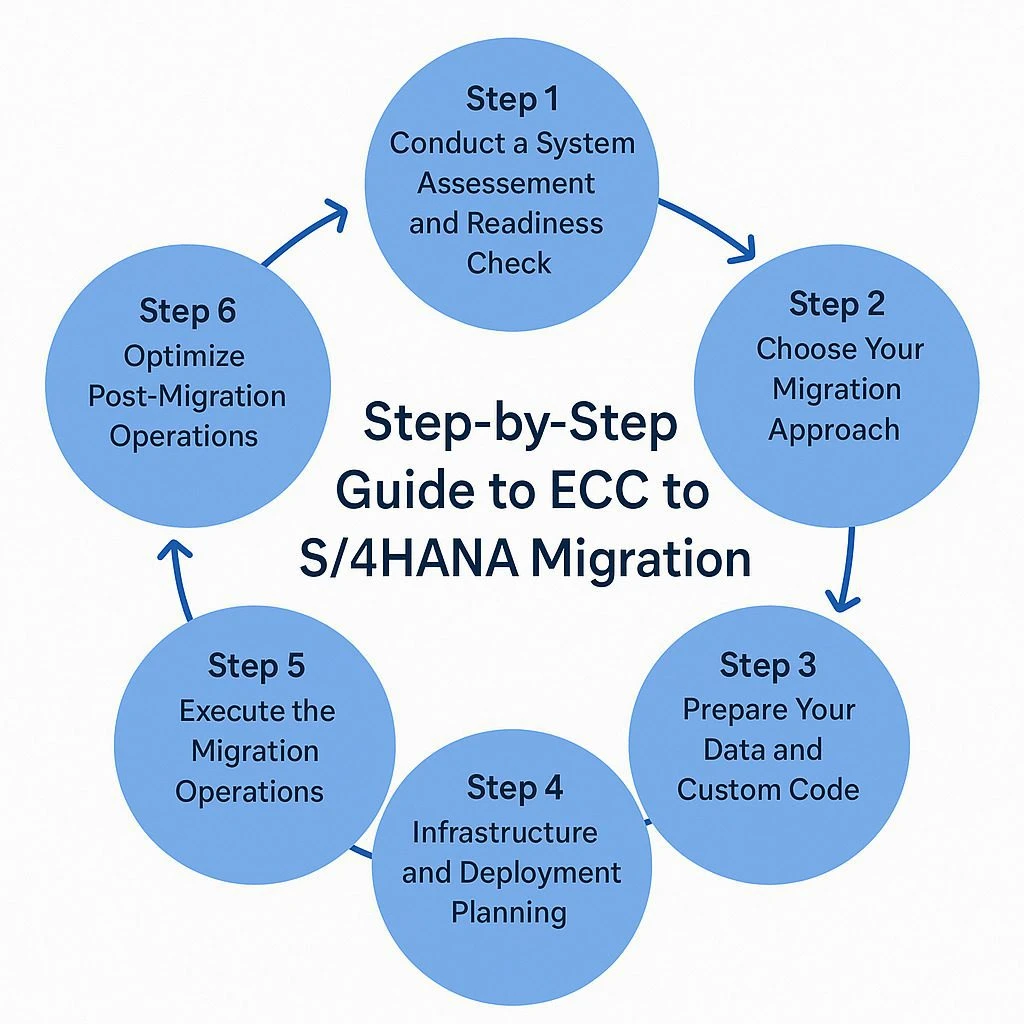ECC to S/4HANA migration is becoming essential as organisations need more than just efficiency, they need intelligent, integrated systems that drive agility, innovation, and scalability. SAP’s S/4HANA has emerged as the foundation for this transformation, offering real-time analytics, simplified architecture, and next-generation business capabilities.
For companies still operating on SAP ECC, migrating to S/4HANA is not merely an upgrade, it’s a strategic move toward digital resilience and future readiness.
This step-by-step guide outlines the technical and strategic aspects of migrating from SAP ECC to S/4HANA, key considerations for a seamless transition, and how partnering with an expert like Prolifics can accelerate your transformation journey.
What is SAP ECC?
SAP ECC (ERP Central Component) is SAP’s legacy ERP at the heart of the classic SAP Business Suite. It supports core enterprise processes such as:
- Finance & Accounting (FI/CO)
- Sales & Distribution (SD)
- Materials Management & Logistics (MM/WM)
ECC relies on traditional relational databases and batch-oriented processing, which can become slower and less efficient for large data volumes and real-time needs.
What is SAP S/4HANA?
SAP S/4HANA is SAP’s modern, next-generation ERP built natively for the HANA in-memory database. It delivers:
- Faster processing with in-memory computing
- Real-time analytics and embedded reporting
- Simplified data models (fewer tables, no aggregates/indices)
- Improved user experience through SAP Fiori apps
In short: ECC = proven, legacy ERP on traditional databases; S/4HANA = real-time, simplified ERP on HANA with a modern UX.

Why Move from ECC to S/4HANA?
SAP ECC (ERP Central Component) has been a reliable enterprise backbone for decades. However, its dependency on legacy database systems and complex customisations limits its ability to support modern business processes.
With SAP ending ECC support in the near future, the migration to S/4HANA is becoming imperative.
Key Benefits of S/4HANA Migration:
- Real-Time Processing: HANA’s in-memory computing enables instant data insights for faster decision-making.
- Simplified Data Model: Reduces redundancy and improves efficiency with fewer tables and indexes.
- Enhanced User Experience: SAP Fiori delivers a modern, role-based, and intuitive interface.
- Improved Integration: Seamless connectivity across SAP and non-SAP systems through APIs and cloud-native tools.
- Future-Ready Architecture: Enables AI, IoT, analytics, and advanced automation capabilities.
Step-by-Step Guide to ECC to S/4HANA Migration
Migrating from SAP ECC to S/4HANA entails transferring existing data, configurations, and customisations to harness the enhanced performance and innovations of S/4HANA. The following methods and steps outline a structured approach to ensure a smooth and successful migration.

Step 1: Conduct a System Assessment and Readiness Check
Before embarking on the migration, it’s essential to understand the current ECC landscape. This involves analysing system architecture, custom code, data volume, and integration points. SAP’s Readiness Check tool helps evaluate compatibility issues and identifies components that require attention.
Key Activities:
- Assess ECC version, enhancement packs, and database platform.
- Identify obsolete transactions, tables, and customisations.
- Analyse add-ons and third-party integrations for compatibility.
- Conduct a data volume and data quality assessment.
The readiness phase helps create a roadmap for the migration and mitigates risks associated with performance, compliance, and downtime.
Step 2: Choose Your Migration Approach
SAP S/4HANA offers multiple migration paths, depending on your existing environment and business goals. Selecting the right approach ensures minimal disruption while maximising value.
1. Greenfield Implementation
A fresh start with S/4HANA from scratch. Ideal for organisations wanting to redesign processes and eliminate legacy inefficiencies.
Advantages:
- Clean data and optimised processes.
- Opportunity for business transformation.
- Modern architecture aligned with best practices.
2. Brownfield Conversion
Direct system conversion from ECC to S/4HANA while retaining configurations and historical data.
Advantages:
- Reduced implementation time.
- Preserves existing investments.
- Lower risk for mature, stable processes.
3. Hybrid or Selective Data Transition
Combines elements of both, migrating selected data or business units while enabling process redesign where needed.
Advantages:
- Flexibility to adapt.
- Minimised downtime and risk.
- Tailored transformation strategy.
Step 3: Prepare Your Data and Custom Code
Data readiness is crucial for migration success. Data cleansing, archiving, and validation ensure that only relevant and high-quality data moves into S/4HANA. Likewise, ECC custom code must be analysed for compatibility with the HANA data model.
Recommended Practices:
- Use SAP’s Custom Code Migration app for analysis.
- Retire redundant or unused Z-programs.
- Archive historical data that no longer serves operational needs.
- Standardise master data formats across business units.
By focusing on quality over quantity, businesses can streamline system performance and reduce storage costs post-migration.
Step 4: Infrastructure and Deployment Planning
S/4HANA supports multiple deployment options, including on-premises, cloud, and hybrid environments. Choosing the right infrastructure depends on scalability requirements, compliance obligations, and existing IT strategies.
Deployment Models:
- On-Premises: Greater control and customisation, suitable for regulated industries.
- Private Cloud: Managed environment offering scalability and lower maintenance.
- Public Cloud: Subscription-based, highly scalable, ideal for rapid innovation.
- Hybrid: Combines the flexibility of cloud with the stability of on-premises systems.
Leveraging cloud services such as Microsoft Azure or AWS for S/4HANA can optimise performance, reduce infrastructure costs, and enable elasticity for dynamic workloads.
Step 5: Execute the Migration
This is the most critical phase where system conversion or new implementation occurs. The process varies depending on the chosen migration path.
For Brownfield Migration:
- Install and configure the Software Update Manager (SUM) with the Database Migration Option (DMO).
- Execute technical conversion from ECC to S/4HANA.
- Conduct data migration and validation.
- Perform extensive unit, integration, and regression testing.
For Greenfield Implementation:
- Install S/4HANA system in the chosen environment.
- Migrate master and transactional data via SAP Data Services or Migration Cockpit.
- Configure new processes using SAP Best Practices Explorer.
- Execute iterative testing cycles and user training.
Regardless of the approach, rigorous testing, sandbox trials, and validation cycles are vital to ensure data integrity and business continuity.
Step 6: Optimise Post-Migration Operations
After go-live, organisations must focus on continuous optimisation to realise the full value of S/4HANA.
Key Focus Areas:
- Performance Tuning: Leverage HANA’s in-memory analytics for faster queries and reporting.
- Process Optimisation: Use SAP Fiori apps to simplify workflows and enhance user productivity.
- Analytics and Insights: Deploy embedded analytics for real-time operational intelligence.
- Governance and Security: Strengthen access controls, compliance, and audit mechanisms.
Adopting a continuous improvement approach helps organisations stay agile and leverage emerging SAP innovations.
Common Challenges and How to Mitigate Them
While the migration promises long-term rewards, several challenges can derail progress if not addressed early.
| Challenge | Mitigation Strategy |
| Complex legacy customisations | Conduct early code remediation and adopt SAP standard functionality where possible |
| Data inconsistency | Implement robust data governance and cleansing tools |
| Downtime during migration | Use phased cutover strategy and parallel testing |
| Skill gaps | Engage certified migration experts and training programs |
| Change resistance | Foster cross-department collaboration and strong change management |
Proactive planning, automation tools, and experienced partners significantly reduce the complexity of migration.
The Strategic Value of S/4HANA Migration
S/4HANA migration is more than a technical exercise, it’s a strategic enabler for digital transformation. By consolidating fragmented systems, improving visibility, and enabling predictive decision-making, it positions enterprises to innovate faster and operate smarter.
Key strategic outcomes include:
- 40–60% reduction in system complexity.
- 30–50% faster reporting and analytics.
- Real-time integration with supply chain, finance, and customer experience platforms.
- Foundation for AI-driven operations, predictive maintenance, and intelligent automation.
Partner with Prolifics for a Seamless S/4HANA Migration
Migration demands more than tools — it requires experience, precision, and strategy. Prolifics combines deep SAP expertise, automation accelerators, and proven methodologies to deliver a low-risk, high-impact migration.
Our approach ensures:
- Business continuity
- Optimised data governance
- Faster time-to-value
Whether you’re planning a greenfield, brownfield, or hybrid migration, our experts tailor your roadmap for success.




